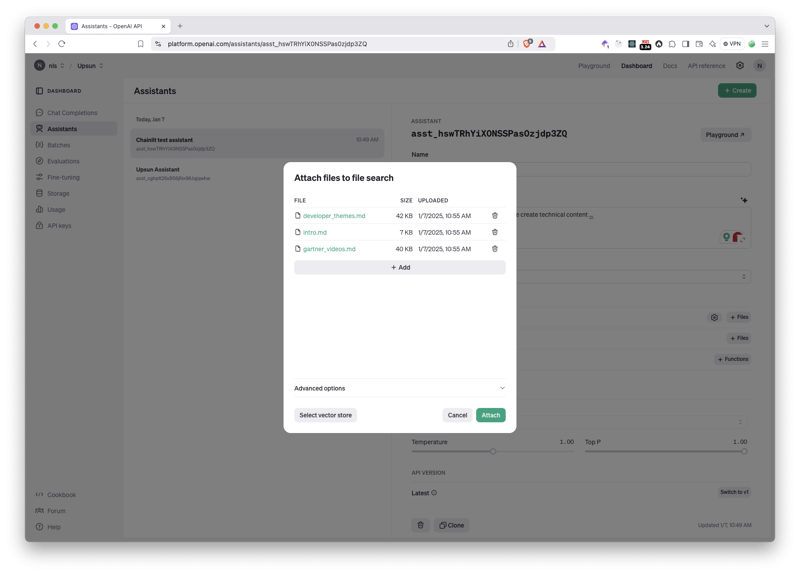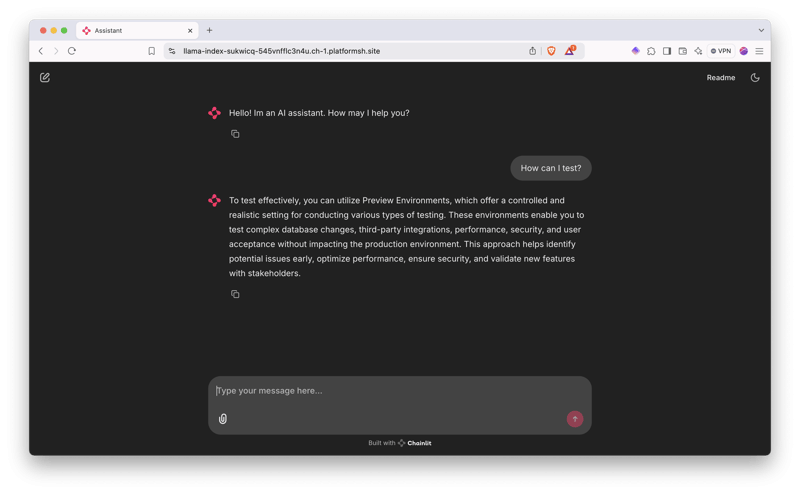Chainlit: A Scalable Conversational AI Framework
Chainlit is an open-source, asynchronous Python framework designed for building robust and scalable conversational AI applications. It offers a flexible foundation, allowing developers to integrate external APIs, custom logic, and local models seamlessly.

This tutorial demonstrates two Retrieval Augmented Generation (RAG) implementations within Chainlit:
- Leveraging OpenAI Assistants with uploaded documents.
- Utilizing llama_index with a local document folder.
Local Chainlit Setup
Virtual Environment
Create a virtual environment:
mkdir chainlit && cd chainlit python3 -m venv venv source venv/bin/activate
Install Dependencies
Install required packages and save dependencies:
pip install chainlit pip install llama_index # For implementation #2 pip install openai pip freeze > requirements.txt
Test Chainlit
Start Chainlit:
chainlit hello
Access the placeholder at http://www.miracleart.cn/link/2674cea93e3214abce13e072a2dc2ca5

Upsun Deployment
Git Initialization
Initialize a Git repository:
git init .
Create a .gitignore file:
<code>.env database/** data/** storage/** .chainlit venv __pycache__</code>
Upsun Project Creation
Create an Upsun project using the CLI (follow prompts). Upsun will automatically configure the remote repository.
Configuration
Example Upsun configuration for Chainlit:
applications:
chainlit:
source:
root: "/"
type: "python:3.11"
mounts:
"/database":
source: "storage"
source_path: "database"
".files":
source: "storage"
source_path: "files"
"__pycache__":
source: "storage"
source_path: "pycache"
".chainlit":
source: "storage"
source_path: ".chainlit"
web:
commands:
start: "chainlit run app.py --port $PORT --host 0.0.0.0"
upstream:
socket_family: tcp
locations:
"/":
passthru: true
"/public":
passthru: true
build:
flavor: none
hooks:
build: |
set -eux
pip install -r requirements.txt
deploy: |
set -eux
# post_deploy: |
routes:
"https://{default}/":
type: upstream
upstream: "chainlit:http"
"https://www.{default}":
type: redirect
to: "https://{default}/"
Set the OPENAI_API_KEY environment variable via Upsun CLI:
upsun variable:create env:OPENAI_API_KEY --value=sk-proj[...]
Deployment
Commit and deploy:
git add . git commit -m "First chainlit example" upsun push
Review the deployment status. Successful deployment will show Chainlit running on your main environment.

Implementation 1: OpenAI Assistant & Uploaded Files
This implementation uses an OpenAI assistant to process uploaded documents.
Assistant Creation
Create a new OpenAI assistant on the OpenAI Platform. Set system instructions, choose a model (with text response format), and keep the temperature low (e.g., 0.10). Copy the assistant ID (asst_[xxx]) and set it as an environment variable:
upsun variable:create env:OPENAI_ASSISTANT_ID --value=asst_[...]
Content Upload
Upload your documents (Markdown preferred) to the assistant. OpenAI will create a vector store.


Assistant Logic (app.py)
Replace app.py content with the provided code. Key parts: @cl.on_chat_start creates a new OpenAI thread, and @cl.on_message sends user messages to the thread and streams the response.
Commit and deploy the changes. Test the assistant.

Implementation 2: OpenAI llama_index
This implementation uses llama_index for local knowledge management and OpenAI for response generation.
Branch Creation
Create a new branch:
mkdir chainlit && cd chainlit python3 -m venv venv source venv/bin/activate
Folder Creation and Mounts
Create data and storage folders. Add mounts to the Upsun configuration.
app.py Update
Update app.py with the provided llama_index code. This code loads documents, creates a VectorStoreIndex, and uses it to answer queries via OpenAI.
Deploy the new environment and upload the data folder. Test the application.

Bonus: Authentication
Add authentication using a SQLite database.
Database Setup
Create a database folder and add a mount to the Upsun configuration. Create an environment variable for the database path:
pip install chainlit pip install llama_index # For implementation #2 pip install openai pip freeze > requirements.txt
Authentication Logic (app.py)
Add authentication logic to app.py using @cl.password_auth_callback. This adds a login form.
Create a script to generate hashed passwords. Add users to the database (using hashed passwords). Deploy the authentication and test login.

Conclusion
This tutorial demonstrated deploying a Chainlit application on Upsun with two RAG implementations and authentication. The flexible architecture allows for various adaptations and integrations.
The above is the detailed content of Experiment with Chainlit AI interface with RAG on Upsun. For more information, please follow other related articles on the PHP Chinese website!

Hot AI Tools

Undress AI Tool
Undress images for free

Undresser.AI Undress
AI-powered app for creating realistic nude photos

AI Clothes Remover
Online AI tool for removing clothes from photos.

Clothoff.io
AI clothes remover

Video Face Swap
Swap faces in any video effortlessly with our completely free AI face swap tool!

Hot Article

Hot Tools

Notepad++7.3.1
Easy-to-use and free code editor

SublimeText3 Chinese version
Chinese version, very easy to use

Zend Studio 13.0.1
Powerful PHP integrated development environment

Dreamweaver CS6
Visual web development tools

SublimeText3 Mac version
God-level code editing software (SublimeText3)
 How to handle API authentication in Python
Jul 13, 2025 am 02:22 AM
How to handle API authentication in Python
Jul 13, 2025 am 02:22 AM
The key to dealing with API authentication is to understand and use the authentication method correctly. 1. APIKey is the simplest authentication method, usually placed in the request header or URL parameters; 2. BasicAuth uses username and password for Base64 encoding transmission, which is suitable for internal systems; 3. OAuth2 needs to obtain the token first through client_id and client_secret, and then bring the BearerToken in the request header; 4. In order to deal with the token expiration, the token management class can be encapsulated and automatically refreshed the token; in short, selecting the appropriate method according to the document and safely storing the key information is the key.
 Explain Python assertions.
Jul 07, 2025 am 12:14 AM
Explain Python assertions.
Jul 07, 2025 am 12:14 AM
Assert is an assertion tool used in Python for debugging, and throws an AssertionError when the condition is not met. Its syntax is assert condition plus optional error information, which is suitable for internal logic verification such as parameter checking, status confirmation, etc., but cannot be used for security or user input checking, and should be used in conjunction with clear prompt information. It is only available for auxiliary debugging in the development stage rather than substituting exception handling.
 What are Python type hints?
Jul 07, 2025 am 02:55 AM
What are Python type hints?
Jul 07, 2025 am 02:55 AM
TypehintsinPythonsolvetheproblemofambiguityandpotentialbugsindynamicallytypedcodebyallowingdeveloperstospecifyexpectedtypes.Theyenhancereadability,enableearlybugdetection,andimprovetoolingsupport.Typehintsareaddedusingacolon(:)forvariablesandparamete
 How to iterate over two lists at once Python
Jul 09, 2025 am 01:13 AM
How to iterate over two lists at once Python
Jul 09, 2025 am 01:13 AM
A common method to traverse two lists simultaneously in Python is to use the zip() function, which will pair multiple lists in order and be the shortest; if the list length is inconsistent, you can use itertools.zip_longest() to be the longest and fill in the missing values; combined with enumerate(), you can get the index at the same time. 1.zip() is concise and practical, suitable for paired data iteration; 2.zip_longest() can fill in the default value when dealing with inconsistent lengths; 3.enumerate(zip()) can obtain indexes during traversal, meeting the needs of a variety of complex scenarios.
 What are python iterators?
Jul 08, 2025 am 02:56 AM
What are python iterators?
Jul 08, 2025 am 02:56 AM
InPython,iteratorsareobjectsthatallowloopingthroughcollectionsbyimplementing__iter__()and__next__().1)Iteratorsworkviatheiteratorprotocol,using__iter__()toreturntheiteratorand__next__()toretrievethenextitemuntilStopIterationisraised.2)Aniterable(like
 Python FastAPI tutorial
Jul 12, 2025 am 02:42 AM
Python FastAPI tutorial
Jul 12, 2025 am 02:42 AM
To create modern and efficient APIs using Python, FastAPI is recommended; it is based on standard Python type prompts and can automatically generate documents, with excellent performance. After installing FastAPI and ASGI server uvicorn, you can write interface code. By defining routes, writing processing functions, and returning data, APIs can be quickly built. FastAPI supports a variety of HTTP methods and provides automatically generated SwaggerUI and ReDoc documentation systems. URL parameters can be captured through path definition, while query parameters can be implemented by setting default values ??for function parameters. The rational use of Pydantic models can help improve development efficiency and accuracy.
 How to test an API with Python
Jul 12, 2025 am 02:47 AM
How to test an API with Python
Jul 12, 2025 am 02:47 AM
To test the API, you need to use Python's Requests library. The steps are to install the library, send requests, verify responses, set timeouts and retry. First, install the library through pipinstallrequests; then use requests.get() or requests.post() and other methods to send GET or POST requests; then check response.status_code and response.json() to ensure that the return result is in compliance with expectations; finally, add timeout parameters to set the timeout time, and combine the retrying library to achieve automatic retry to enhance stability.
 Python variable scope in functions
Jul 12, 2025 am 02:49 AM
Python variable scope in functions
Jul 12, 2025 am 02:49 AM
In Python, variables defined inside a function are local variables and are only valid within the function; externally defined are global variables that can be read anywhere. 1. Local variables are destroyed as the function is executed; 2. The function can access global variables but cannot be modified directly, so the global keyword is required; 3. If you want to modify outer function variables in nested functions, you need to use the nonlocal keyword; 4. Variables with the same name do not affect each other in different scopes; 5. Global must be declared when modifying global variables, otherwise UnboundLocalError error will be raised. Understanding these rules helps avoid bugs and write more reliable functions.






